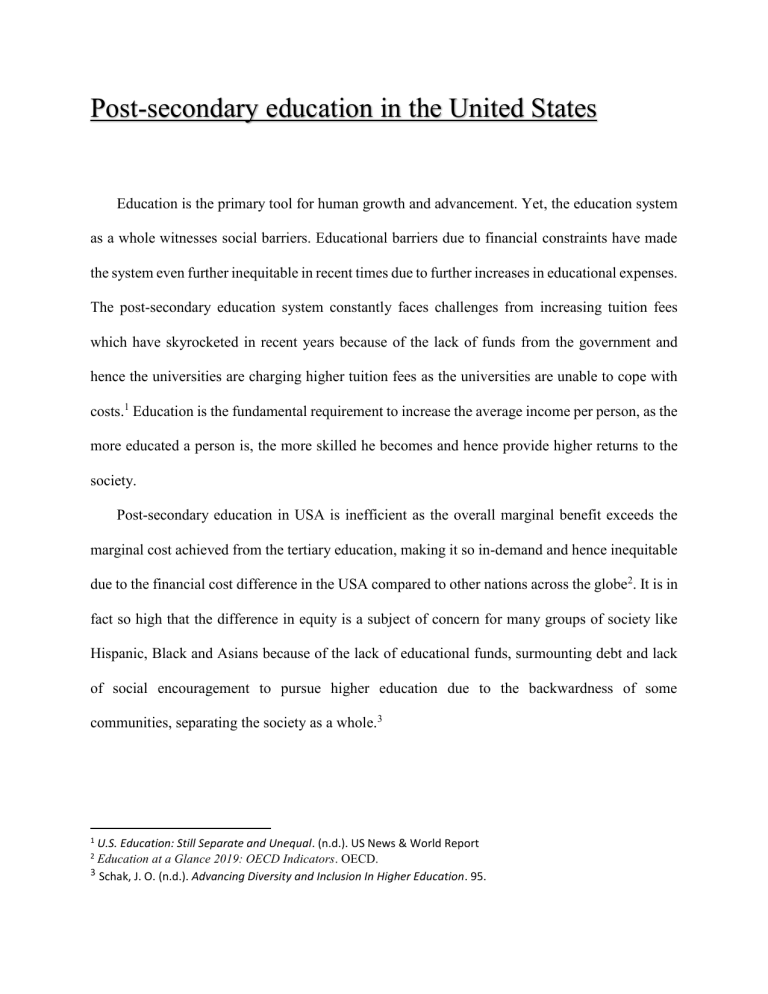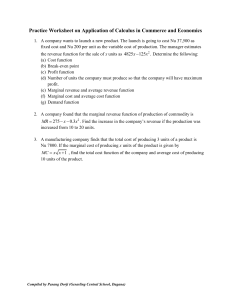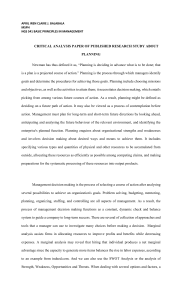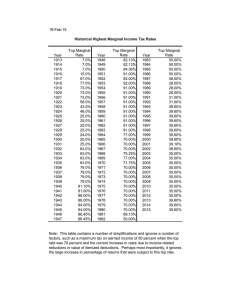
Post-secondary education in the United States Education is the primary tool for human growth and advancement. Yet, the education system as a whole witnesses social barriers. Educational barriers due to financial constraints have made the system even further inequitable in recent times due to further increases in educational expenses. The post-secondary education system constantly faces challenges from increasing tuition fees which have skyrocketed in recent years because of the lack of funds from the government and hence the universities are charging higher tuition fees as the universities are unable to cope with costs.1 Education is the fundamental requirement to increase the average income per person, as the more educated a person is, the more skilled he becomes and hence provide higher returns to the society. Post-secondary education in USA is inefficient as the overall marginal benefit exceeds the marginal cost achieved from the tertiary education, making it so in-demand and hence inequitable due to the financial cost difference in the USA compared to other nations across the globe2. It is in fact so high that the difference in equity is a subject of concern for many groups of society like Hispanic, Black and Asians because of the lack of educational funds, surmounting debt and lack of social encouragement to pursue higher education due to the backwardness of some communities, separating the society as a whole.3 1 U.S. Education: Still Separate and Unequal. (n.d.). US News & World Report Education at a Glance 2019: OECD Indicators. OECD. 3 Schak, J. O. (n.d.). Advancing Diversity and Inclusion In Higher Education. 95. 2 The education system by CBA (cost-benefit analysis) The objective of a general education system is to include the general goals like producing good citizens, developing the cultural heritage, and absorbing the knowledge. The input to education is teachers, students and resources like books, school facilities, technology and equipment. The real costs for the education include not only the public expenditure but also the private costs. Some countries are highly dependent on indirect private funding for education hence private funding cannot be neglected. The marginal cost involved in educating one is the per unit cost involved to attain the output or goals. Many economists study the education system by cost-benefit application to draft and improve education policy. Education has various types of costs associated with it. Direct costs include all the visible costs incurred to access education. Indirect costs include the opportunity costs which is the cost that is foregone due to the time and earning lost foregone to continue study. The sum of individual costs and institutional costs is the total social cost of education. It also includes the funds derived as part of scholarships, bursaries, loans and grants. These costs aren’t included on the part of a consumer but are added to the net cost for the whole post-secondary education. Furthermore, education costs are not the same across the World and this doesn’t mean that more expensive education lead to more knowledge. Americans spend around $30K per year per student which is relatively double than what is costs in most developed nations.4 This shows how US overspends per capita and how the costs exceed the benefit received compared to other nations and hence a deadweight loss arises because the skill is worth the same yet the costs are higher. But 4 Education at a Glance 2019: OECD Indicators. OECD. people still pay for this overpriced benefit because the marginal benefit received will always exceed its long-term marginal cost. The benefit received from post-graduation or further higher education leads to a significantly large income compared to the ones who don’t pursue education.5 Another added benefit to higher education is that it provides advanced skills and knowledge required at skillful workplaces. But even the marginal benefits received are widely diverse, as a person in the tertiary sector has a higher income compared to a person involved in the primary or secondary sector, postsecondary education has further diverse and difference in marginal benefits depending on the field selection. Marginal benefits increase as part of the externalities because with a higher education level, the benefits are greater as the more educated tend to be more enterprising and hence bring more economic value to the community. Figure 1 Source-energyeducation.ca 5 https://www.russellsage.org/research/social-inequality/social-inequality-and-educational-disadvantage The red region shows the deadweight loss. EMB stands for external marginal benefit. This deadweight loss exists because in a perfect market, every person would obtain the exact level of education that they need but because this is almost impossible to do, it is better to have everyone over-educated. The social benefit (SD) of obtaining higher education is greater than that of private benefit (D). because we all don’t the social benefit and are only interested in its private benefit, we purchase a level of education that is not socially optimal. Hence, we can see the higher education system in US is highly complicated due to many externalities and the private marginal cost and benefit are way different than the true marginal costs and benefit. The social costs are very difficult to be measured in this market and its true accuracy cannot be measured. But we can still estimate it to a point where we conclude that the private marginal cost of education is higher than its private marginal benefit, but overall marginal benefit still exceeds the marginal cost. The marginal cost of higher education has increased subsequently over the last few years, but the benefit derived from education will always exceed the cost as it has proven to be a fundamental pillar to human growth. The market is inefficient, but its ever-increasing demand growth will not plummet anytime soon hence the competitiveness for better education will increase. The barriers making the system highly inequitable- Income also has a high influence on the type of education a student can have. Affordability has a very high link to whether the students can receive post-secondary education. It is not the same across the World and especially the marginal costs to enter the top universities are significantly higher hence disallowing many to even think of dreaming to enrol. The primary criterion being merit without a bias helps to make the system more equitable. Education obtained prior to secondary is also very essential to predict how post-secondary education is more inequitable. Department of Education study found that 45 percent of high-poverty schools received less state and local funding than was typical for other schools in their district. This makes them less competitive to get admissions in post-secondary institutions and hence suppressing the number of students who enter the system. Source- https://www2.ed.gov/advancing-diversity-inclusion The figure above shows how the ethnicity is diverged by races. The percentage of students with zero expected family contribution (EFC) — an indicator of high financial need — is 47 percent for Hispanic students, 60 percent for black students, and 37 percent for Asian students. In comparison, only 29 percent of white students have zero EFC; and over a third have an EFC of more than $10,000, suggesting many white students have more resources to pay for attending college. The percentage of students with zero expected family contribution (EFC) — an indicator of high financial need — is 47 percent for Hispanic students, 60 percent for black students, and 37 percent for Asian students. In comparison, only 29 percent of white students have zero EFC; and over a third have an EFC of more than $10,000, suggesting many white students have more resources to pay for attending college. The United States does not meet UNESCO’s benchmark of a 15.00% share of total public expenditure on education.6 This shows how just the financial constraints have made the US education system so inefficient because financing is the basic need, which if denied then cannot allow groups from various ethnicity to pursue further education. “In another disgusting case of corruption, the state of California was found guilty in 2013 of diverting tens of millions of dollars in state and federal education funds to other projects”.7 USA’s over-expensive post-secondary education is yet burdened on these ethnic groups who are still in major financial needs for education8 by such funds-diverging tactics further depriving them of their rightful resources. 6 ttps://www.heartland.org/news-opinion/news/uneducated-why-american-education-is-fundamentally-flawed https://www.heartland.org/news-opinion/news/uneducated-why-american-education-is-fundamentally-flawed 8 https://www.usnews.com/news/blogs/data-mine/2015/01/28/us-education-still-separate-and-unequal 7 Figure 2 Relative earnings of tertiary-educated adults, by educational attainment (2017) 25–64-year-old workers (full- and part-time workers), upper secondary education = 100 Bachelor's or equivalent Short-cycle tertiary Master's, doctoral or equivalent 500 450 400 350 300 250 200 150 100 50 . Year of reference differs from 2017. . Bachelor's or equivalent includes master's, doctoral or equivalent. . Index 100 refers to the combined ISCED levels 3 and 4 of the educational attainment levels in the ISCED 2011 classification. . Bachelor's, master's, doctoral or equivalent include short-cycle tertiary. Countries are ranked in descending order of the relative earnings of 25-64 year-olds with a bachelor's or equivalent qualification. Source: OECD (2019) Earnings tend to increase with the level of educational learning. On average across OECD countries, adults (aged 25-64) without upper secondary education earn about 21% less for parttime or full-time employment than those with upper secondary education, while those with a tertiary degree earn about 57% more (Figure 2). This is very similar to what ethnic groups their families belong because their parents have incomes similar to their education level which we have seen in the chart above. Thus, incomes and education have a proportional relation and have the same inequitable problems as this has been going from generations. Post-secondary education is very expensive in the States. This is largely because there is no governing body to controlling prices of education in the USA. Moreover, all the prestigious schools in US are private and hence over-inflating the costs that students must pay. Even for the public universities the costs are surmounting new amounts and as government is loosening its funding to the public universities, they are relying more on funds from tuition. This enhances an unfair share of equity in the education system making the system inequitable and unfair by the results point of view, hence the socio-economic disparity scenario arises further separating the ethnic groups. ConclusionHence, we conclude that the post-secondary education system in US is firstly very complicated but through different factors we can understand that this education system is inefficient where the true marginal costs is not equal to true marginal benefits and private marginal costs and benefits play a huge role in the system along with the externalities. The total marginal benefit exceeds the marginal cost. Compared to it, the market is highly inequitable due to differences in incomes which causes widespread difference between how accessible postsecondary education is for the people from different races, cultures and groups. With time it is becoming more equitable but still has a long way to go. BibliographyAdomait, E. J., & Maranta, R. G. (2012). scarcity reveals value. In Cocktail Party Economics: The big ideas and scintillating small talk about markets. essay, Pearson Prentice Hall. Adomait, E., & Maranta, R. (2012). public health and education. In Cocktail Party Economics: The big ideas and scintillating small talk about markets. essay, Pearson Prentice Hall. Equity of Opportunity | U.S. Department of Education. (n.d.). Retrieved October 26, 2021, from https://www.ed.gov/equity OECD. (2012). Equity and Quality in Education: Supporting Disadvantaged Students and Schools. OECD. https://doi.org/10.1787/9789264130852-en OECD. (2018). OECD Handbook for Internationally Comparative Education Statistics 2018: Concepts, Standards, Definitions and Classifications. OECD. https://doi.org/10.1787/9789264304444-en OECD. (2019). Education at a Glance 2019: OECD Indicators. OECD. https://doi.org/10.1787/f8d7880d-en OECD - 2012—Equity and Quality in Education Supporting Disadv.pdf. (n.d.). Retrieved October 26, 2021, from https://www.oecd.org/education/school/50293148.pdf Schak, J. O. (n.d.). Advancing Diversity and Inclusion In Higher Education. 95. Tsang, M. C. (1988). Cost Analysis for Educational Policymaking: A Review of Cost Studies in Education in Developing Countries. Review of Educational Research, 58(2), 181–230. https://doi.org/10.2307/1170334 U.S. Education: Still Separate and Unequal. (n.d.). US News & World Report. Retrieved October 31, 2021, from //www.usnews.com/news/blogs/data-mine/2015/01/28/us-education-stillseparate-and-unequal







